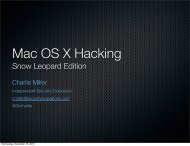ISE SOHO Vulnerability Catalog Published - Independent Security ...
ISE SOHO Vulnerability Catalog Published - Independent Security ...
ISE SOHO Vulnerability Catalog Published - Independent Security ...
Create successful ePaper yourself
Turn your PDF publications into a flip-book with our unique Google optimized e-Paper software.
ASUS RT-‐N56U <br />
<strong>Vulnerability</strong>: Cross-‐Site Request Forgery <br />
CVE: CVE-2013-3093<br />
Description<br />
The ASUS RT-N56U router is susceptible to several Cross-Site Request Forgery attacks,<br />
which allows an attacker to forge HTML forms and execute actions on behalf of the<br />
target user. <strong>ISE</strong> created a proof of concept that when executed by an unsuspecting user,<br />
changes the administrator credentials, enables remote management, and gives the attacker<br />
reverse-shell access to the router.<br />
Attack Requirements<br />
♦ The victim must have an active web application session on their ASUS router.<br />
♦ The victim must follow a link crafted by an attacker (e.g., by clicking the link<br />
directly, or through some other mechanism such as redirection from a malicious<br />
site).<br />
♦ The victim must have the necessary permissions to render and execute the forged<br />
HTTP.<br />
Details<br />
All HTML forms present in the ASUS RT-N56U are susceptible to Cross-Site Request<br />
Forgery.<br />
Impact<br />
If an unauthenticated remote attacker is able to fool an authenticated user into clicking a<br />
malicious link, the attacker is able to launch an attack that has the capability to<br />
compromise the router.<br />
Recommendations to the Vendor<br />
♦ Including an unpredictable token in each HTTP request submitted to the web<br />
server can prevent Cross-Site Request Forgery. At a minimum, these tokens<br />
should be unique to each user, but it is recommended that each HTML form<br />
contain unique tokens.<br />
♦ In addition to HTML form tokens, HTTP referrer checking should be enabled.<br />
♦ Additional information for vendors regarding immediate and long term fixes for<br />
these issues can be found here: http://www.securityevaluators.com/content/casestudies/routers/#recommendationsVendors<br />
<br />
88



